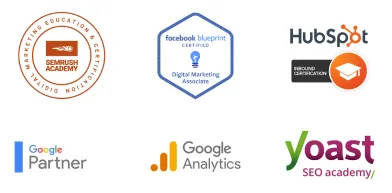TO LEARN IS TO GROW
Learning Center
We do our research and publish our results. Should probably call this the Growing Center.


Corporate Branding: Top 10 Things You Need
Which companies come to your mind when you hear the term corporate branding? Perhaps Apple with its functional and minimalist design? Or Nike’s iconic swoosh that represents speed and power? Or McDonald’s brand image that speaks about family, joy, and love.
If you believe that the creation of iconic branding is best reserved for corporate bigwigs, think again. After all, a solid corporate branding is a surefire way to stand out from the crowded, cutthroat market.
Your company name, logo, design, tagline, brand identity, and brand voice reflect your overall corporate brand, which in turn helps you identify the customer experience you want to provide.
What is Corporate Branding?
Corporate branding is the one that “humanizes” your company. it allows your customers to make an emotional connection that is the foundation of brand loyalty, retention, and ultimately, conversions that will drive your business long-term growth.
To put this in perspective, a Nielson report has suggested that 59% of customers prefer to purchase new products from a brand they already know. Therefore, if what you’re aiming for is a sustainable growth, the first step is to make a human connection, aka trust and confidence, with your customers.
In a nutshell, branding your company consists of three elements: brand strategy, brand identity, and brand marketing.
Brand strategy acts like a blueprint or a vision that helps your company stand out from the competition and at the same time to gain the trust and confidence of customers.
Brand identity, meanwhile, is the image that you create for your customers. It is a collection of elements—e.g., the colors, logos, messaging, and packaging—that reinforces the company’s existing reputation.
And lastly, brand marketing is the way you promote your products and services in a way that it complements and reinforces the overall “feel” of your brand. Its goal is to create a bridge between your products and the customers.
1. Brand Mission Statement
To make a human connection with your customers, the first step is to identify your company’s mission. After all, people are not concerned about your product per se, but on how it can add value to their life. This is the reason why successful brands have always adopted a customer-based approach instead of a product-based one.
To come up with a solid brand mission statement, you must be able to answer these questions:
Why does my company exist?
What makes us different from the competitors?
What value do I offer to my customers?
You must provide specific answers to the aforementioned questions to come up with a solid and inspiring mission statement.
To put this in perspective, take a look at the mission statement of these iconic, household name brands:
“To bring inspiration and innovation to every athlete in the world. “- NIKE
“To inspire and nurture the human spirit – one person, one cup, and one neighborhood at a time.” – Starbucks
“To make a contribution to the world by making tools for the mind that advance humankind.” – Apple
2. Strong Company Values, Qualities, and Benefits
You must be precise with your corporate values and key qualities that help your company stand out from your competitors. The focus here is not your product and service, but on how you add value to the customer’s life and how you can help them solve their pain points.
3. Strong Brand Voice
What kind of emotion, thought, or imagery you want to elicit from your customers? You can answer this if you put yourself in their shoes.
Take note that your brand voice depends on your company’s target customer audience, mission statement, and industry. That voice interacts with your customers, which in turn affects how they respond to your message.
A powerful brand voice resonates with your customers as it reflects their core values, lifestyle, pain points, expectations, and hopes.
4. Outstanding Brand Personality
While there are many ways to skin the marketing cat, great marketing strategies have one thing in common: They incite positive emotions from the customer.
Brand personality is about humanizing your brand, i.e., attributing human traits to your company in order to make a real connection with your customers. After all, you’re dealing with people and not just some numbers and statistics.
5. Appealing Story, Messaging, and Tagline
When building your corporate branding, you need to tell your customers a captivating, original story. A great story can stoke positive human emotions, which in turn allow your customers to relate to your brand.
To put this in perspective, TOMS Shoes has been successful in growing a solid social media following with its positive brand perception. On their website, they are upfront with their message: “Improving lives. With every product you purchase, TOMS will help a person in need. One for One.”
The simple, straightforward language they use is powerful enough to elicit a sense of belongingness and camaraderie, right? You can replicate their success by using the same language that stokes positive human emotions.
6. Memorable Distinctive Company Logo
Have you seen a business that operates without any logo, which acts like an identification card? Do you think a company can flourish or at least survive amidst this crowded market without having one?
Take note that your logo will have a significant impact on brand recall, which is the key to the long-term success of your business.
Once you are able to define your mission statement, it’s a lot easier to design a company logo that reflects your core values. Colors, fonts, imagery are all visual symbols that will tell a story to your customers.
Remember that a good company logo is memorable and unique, fostering customer loyalty and brand recall.
When you create your logo, it has to be appealing and memorable that it differentiates you from the rest of the competition. In addition, it must look professionally done as it will serve as your ID, appearing on everything related to your business–e.g., from packaging, social media channels, and business cards, to products and company cars.
Because your logo is a readily-identifiable symbol that represents your business, you might want to hire a professional graphic designer or artist instead of resorting to some bootstrapping hacks. Remember, this is the visual symbol that reinforces brand loyalty and name recall.
7. Appropriate Use of Color Palette
Colors are not just aesthetic, visual elements, as they also elicit specific human emotions and “associations” that will be part of your overall brand identity.
The right use of colors for your logo has the power to elicit a specific emotional response from your customers and sometimes even trigger a detailed memory. In fact, a study titled “’Exciting and Competent Blue” has revealed that colors have a direct impact on the buyers’ intentions as these visual elements convey the brand’s identity and core values.
Below is the list of colors and their respective associations:
Red – power, passion, aggression, danger, energy, and love
Purple – femininity, royalty, mystery, sophistication, and spirituality
Blue – strength, trust, order, cleanliness, and peace
Yellow – warmth, happiness, positivity, and hope
Orange – warmth, cheerfulness, optimism, and creativity
Green – environment-friendliness, cleanliness, nature, progress, health, and finances
8. Visually Appealing Official Fonts
Aside from colors, the fonts also serve as a visual representation of your brand identity and so it is a sacrosanct rule that they send a clear message to the public. For instance, a fashion brand should use fonts that appear sophisticated and striking, while a technology brand should resort to something that looks modern and sleek.
To put it simply, the font style you choose must be in line with your business core values and identity. How do you want to be seen by your customers? An innovative startup? A family-oriented business that sticks to tradition? Or a creative firm composed of millennials?
If you want to use font pairings, consider the web-safe fonts stated below:
Thin san-serif fonts represent a sophisticated look
Traditional serif fonts appear conservative and corporate-like
Thick and rounded sans serif fonts look warm and friendly
Bold serif headers plus nondescript sans-serif subheaders represent an authoritative, reliable look
Minimal sans-serif fonts look corporate and professional
9. Captivating Imagery and On-brand Supporting Graphics
In terms of getting your message across in the quickest way possible, the use of powerful imagery is your best bet. After all, the right visual representation can elicit the desired emotional response and a detailed memory or experience.
Your brand identity must be also supported by graphics or icons, which represent your company’s core values.
10. Style Guide
To get everyone on the team on board, your company must have a style guide on how to use your company logo, icons, and other visual representations of your company. The goal is to use them consistently to foster brand recall and customer loyalty and so they must appear on the packaging, business cards, products, social media channels, etc.
Be Smart in Your Corporate Branding
While the long-term success of your company boils down to your product and service, remember that brand identity and visual representations are the key to customer retention and conversion.
By having a clear brand identity that is conveyed by your visual representations, it is easier to catch the attention of customers amidst the white noise and constant bombardment of ads.

Corporate Branding: Top 10 Things You Need
Which companies come to your mind when you hear the term corporate branding? Perhaps Apple with its functional and minimalist design? Or Nike’s iconic swoosh that represents speed and power? Or McDonald’s brand image that speaks about family, joy, and love.
If you believe that the creation of iconic branding is best reserved for corporate bigwigs, think again. After all, a solid corporate branding is a surefire way to stand out from the crowded, cutthroat market.
Your company name, logo, design, tagline, brand identity, and brand voice reflect your overall corporate brand, which in turn helps you identify the customer experience you want to provide.
What is Corporate Branding?
Corporate branding is the one that “humanizes” your company. it allows your customers to make an emotional connection that is the foundation of brand loyalty, retention, and ultimately, conversions that will drive your business long-term growth.
To put this in perspective, a Nielson report has suggested that 59% of customers prefer to purchase new products from a brand they already know. Therefore, if what you’re aiming for is a sustainable growth, the first step is to make a human connection, aka trust and confidence, with your customers.
In a nutshell, branding your company consists of three elements: brand strategy, brand identity, and brand marketing.
Brand strategy acts like a blueprint or a vision that helps your company stand out from the competition and at the same time to gain the trust and confidence of customers.
Brand identity, meanwhile, is the image that you create for your customers. It is a collection of elements—e.g., the colors, logos, messaging, and packaging—that reinforces the company’s existing reputation.
And lastly, brand marketing is the way you promote your products and services in a way that it complements and reinforces the overall “feel” of your brand. Its goal is to create a bridge between your products and the customers.
1. Brand Mission Statement
To make a human connection with your customers, the first step is to identify your company’s mission. After all, people are not concerned about your product per se, but on how it can add value to their life. This is the reason why successful brands have always adopted a customer-based approach instead of a product-based one.
To come up with a solid brand mission statement, you must be able to answer these questions:
Why does my company exist?
What makes us different from the competitors?
What value do I offer to my customers?
You must provide specific answers to the aforementioned questions to come up with a solid and inspiring mission statement.
To put this in perspective, take a look at the mission statement of these iconic, household name brands:
“To bring inspiration and innovation to every athlete in the world. “- NIKE
“To inspire and nurture the human spirit – one person, one cup, and one neighborhood at a time.” – Starbucks
“To make a contribution to the world by making tools for the mind that advance humankind.” – Apple
2. Strong Company Values, Qualities, and Benefits
You must be precise with your corporate values and key qualities that help your company stand out from your competitors. The focus here is not your product and service, but on how you add value to the customer’s life and how you can help them solve their pain points.
3. Strong Brand Voice
What kind of emotion, thought, or imagery you want to elicit from your customers? You can answer this if you put yourself in their shoes.
Take note that your brand voice depends on your company’s target customer audience, mission statement, and industry. That voice interacts with your customers, which in turn affects how they respond to your message.
A powerful brand voice resonates with your customers as it reflects their core values, lifestyle, pain points, expectations, and hopes.
4. Outstanding Brand Personality
While there are many ways to skin the marketing cat, great marketing strategies have one thing in common: They incite positive emotions from the customer.
Brand personality is about humanizing your brand, i.e., attributing human traits to your company in order to make a real connection with your customers. After all, you’re dealing with people and not just some numbers and statistics.
5. Appealing Story, Messaging, and Tagline
When building your corporate branding, you need to tell your customers a captivating, original story. A great story can stoke positive human emotions, which in turn allow your customers to relate to your brand.
To put this in perspective, TOMS Shoes has been successful in growing a solid social media following with its positive brand perception. On their website, they are upfront with their message: “Improving lives. With every product you purchase, TOMS will help a person in need. One for One.”
The simple, straightforward language they use is powerful enough to elicit a sense of belongingness and camaraderie, right? You can replicate their success by using the same language that stokes positive human emotions.
6. Memorable Distinctive Company Logo
Have you seen a business that operates without any logo, which acts like an identification card? Do you think a company can flourish or at least survive amidst this crowded market without having one?
Take note that your logo will have a significant impact on brand recall, which is the key to the long-term success of your business.
Once you are able to define your mission statement, it’s a lot easier to design a company logo that reflects your core values. Colors, fonts, imagery are all visual symbols that will tell a story to your customers.
Remember that a good company logo is memorable and unique, fostering customer loyalty and brand recall.
When you create your logo, it has to be appealing and memorable that it differentiates you from the rest of the competition. In addition, it must look professionally done as it will serve as your ID, appearing on everything related to your business–e.g., from packaging, social media channels, and business cards, to products and company cars.
Because your logo is a readily-identifiable symbol that represents your business, you might want to hire a professional graphic designer or artist instead of resorting to some bootstrapping hacks. Remember, this is the visual symbol that reinforces brand loyalty and name recall.
7. Appropriate Use of Color Palette
Colors are not just aesthetic, visual elements, as they also elicit specific human emotions and “associations” that will be part of your overall brand identity.
The right use of colors for your logo has the power to elicit a specific emotional response from your customers and sometimes even trigger a detailed memory. In fact, a study titled “’Exciting and Competent Blue” has revealed that colors have a direct impact on the buyers’ intentions as these visual elements convey the brand’s identity and core values.
Below is the list of colors and their respective associations:
Red – power, passion, aggression, danger, energy, and love
Purple – femininity, royalty, mystery, sophistication, and spirituality
Blue – strength, trust, order, cleanliness, and peace
Yellow – warmth, happiness, positivity, and hope
Orange – warmth, cheerfulness, optimism, and creativity
Green – environment-friendliness, cleanliness, nature, progress, health, and finances
8. Visually Appealing Official Fonts
Aside from colors, the fonts also serve as a visual representation of your brand identity and so it is a sacrosanct rule that they send a clear message to the public. For instance, a fashion brand should use fonts that appear sophisticated and striking, while a technology brand should resort to something that looks modern and sleek.
To put it simply, the font style you choose must be in line with your business core values and identity. How do you want to be seen by your customers? An innovative startup? A family-oriented business that sticks to tradition? Or a creative firm composed of millennials?
If you want to use font pairings, consider the web-safe fonts stated below:
Thin san-serif fonts represent a sophisticated look
Traditional serif fonts appear conservative and corporate-like
Thick and rounded sans serif fonts look warm and friendly
Bold serif headers plus nondescript sans-serif subheaders represent an authoritative, reliable look
Minimal sans-serif fonts look corporate and professional
9. Captivating Imagery and On-brand Supporting Graphics
In terms of getting your message across in the quickest way possible, the use of powerful imagery is your best bet. After all, the right visual representation can elicit the desired emotional response and a detailed memory or experience.
Your brand identity must be also supported by graphics or icons, which represent your company’s core values.
10. Style Guide
To get everyone on the team on board, your company must have a style guide on how to use your company logo, icons, and other visual representations of your company. The goal is to use them consistently to foster brand recall and customer loyalty and so they must appear on the packaging, business cards, products, social media channels, etc.
Be Smart in Your Corporate Branding
While the long-term success of your company boils down to your product and service, remember that brand identity and visual representations are the key to customer retention and conversion.
By having a clear brand identity that is conveyed by your visual representations, it is easier to catch the attention of customers amidst the white noise and constant bombardment of ads.
Growing Businesses Since 2008
We have helped hundreds of businesses just like yours. Working for or along-side of business owner, managers, staff, or even board of directors, LOJO is ready to be an asset to your business.
Our team has been curated through the years for individual skills, personalities, and capabilities. Our clients put their trust in us to help them grow. We are here to do just that.



Growing Businesses Since 2008
We have helped hundreds of businesses just like yours. Working for or along-side of business owner, managers, staff, or even board of directors, LOJO is ready to be an asset to your business.
Our team has been curated through the years for individual skills, personalities, and capabilities. Our clients put their trust in us to help them grow. We are here to do just that.




Matthew Rogers, President
iProspect Check
After spending several months reviewing multiple proposals from several different companies we engaged LOJO to develop a new website that represents our company effectively. We worked initially with Stephen Platte who helped create the scope of the project. Stephen was knowledgeable and always followed up with me on time and as promised.
He "closed the deal" for LOJO with his professionalism, service orientation and easy going approach. Once we signed the contract we were introduced to Jay Kelly who would be the creative lead for LOJO. This was the most challenging part of the project for my company, as there was no shortage of ideas from our side. Jay managed the project flawlessly, and once we had all agreed to the design, Jay introduced us to Eric.
Eric Lay is one of the founders of LOJO. Eric took the design we had developed and brought it to life. We delivered content as quickly as he requested it. Eric kept the project on task and we responded by exceeding every deadline for content. In turn, once provided, literally not a day went by that Eric didn't add the content and take the next step. In just a few weeks we launched our new website. Eric is a pleasure to work with.
His positive attitude and consultative approach really enhanced the experience and made a big difference for us in the outcome of our project. We would welcome you to visit our website to take a look at the quality work of LOJO. We are very pleased with LOJO and look forward to working with them in the future as we pursue an aggressive SEO strategy."
After spending several months reviewing multiple proposals from several different companies we engaged LOJO to develop a new website that represents our company effectively. We worked initially with Stephen Platte who helped create the scope of the project. Stephen was knowledgeable and always followed up with me on time and as promised.
He "closed the deal" for LOJO with his professionalism, service orientation and easy going approach. Once we signed the contract we were introduced to Jay Kelly who would be the creative lead for LOJO. This was the most challenging part of the project for my company, as there was no shortage of ideas from our side. Jay managed the project flawlessly, and once we had all agreed to the design, Jay introduced us to Eric.
Eric Lay is one of the founders of LOJO. Eric took the design we had developed and brought it to life. We delivered content as quickly as he requested it. Eric kept the project on task and we responded by exceeding every deadline for content. In turn, once provided, literally not a day went by that Eric didn't add the content and take the next step. In just a few weeks we launched our new website. Eric is a pleasure to work with.
His positive attitude and consultative approach really enhanced the experience and made a big difference for us in the outcome of our project. We would welcome you to visit our website to take a look at the quality work of LOJO. We are very pleased with LOJO and look forward to working with them in the future as we pursue an aggressive SEO strategy."

Matthew Rogers, President
iProspect Check
The team at LOJO were wonderful to work with. They are well organized and very patient as we worked through our marketing strategy and developed a well thought out and clear action plan at a reasonable price. We will definitely be back for our future campaign needs."

Jon Crosby, Founder
Dazil

